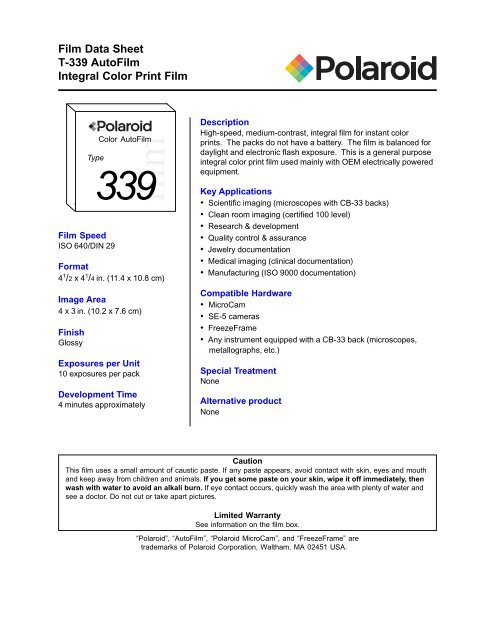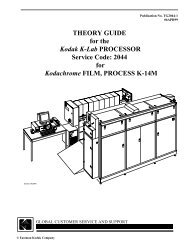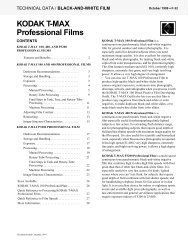Create successful ePaper yourself
Turn your PDF publications into a flip-book with our unique Google optimized e-Paper software.
Film Data Sheet<br />
T-<strong>339</strong> <strong>AutoFilm</strong><br />
Integral Color Print Film<br />
Film Speed<br />
ISO 640/DIN 29<br />
Format<br />
4 1 /2 x 4 1 /4 in. (11.4 x 10.8 cm)<br />
Image Area<br />
4 x 3 in. (10.2 x 7.6 cm)<br />
Finish<br />
Glossy<br />
<br />
Exposures per Unit<br />
10 exposures per pack<br />
Development Time<br />
4 minutes approximately<br />
<br />
<br />
<br />
Description<br />
High-speed, medium-contrast, integral film for instant color<br />
prints. The packs do not have a battery. The film is balanced for<br />
daylight and electronic flash exposure. This is a general purpose<br />
integral color print film used mainly with OEM electrically powered<br />
equipment.<br />
Key Applications<br />
• Scientific imaging (microscopes with CB-33 backs)<br />
• Clean room imaging (certified 100 level)<br />
• Research & development<br />
• Quality control & assurance<br />
• Jewelry documentation<br />
• Medical imaging (clinical documentation)<br />
• Manufacturing (ISO 9000 documentation)<br />
Compatible Hardware<br />
• MicroCam<br />
• SE-5 cameras<br />
• FreezeFrame<br />
• Any instrument equipped with a CB-33 back (microscopes,<br />
metallographs, etc.)<br />
Special Treatment<br />
None<br />
Alternative product<br />
None<br />
Caution<br />
This film uses a small amount of caustic paste. If any paste appears, avoid contact with skin, eyes and mouth<br />
and keep away from children and animals. If you get some paste on your skin, wipe it off immediately, then<br />
wash with water to avoid an alkali burn. If eye contact occurs, quickly wash the area with plenty of water and<br />
see a doctor. Do not cut or take apart pictures.<br />
Limited Warranty<br />
See information on the film box.<br />
“Polaroid”, “<strong>AutoFilm</strong>”, “Polaroid MicroCam”, and “FreezeFrame” are<br />
trademarks of Polaroid Corporation, Waltham, MA 02451 USA.
Film Data Sheet<br />
Technical Data<br />
T-779 and T-<strong>339</strong> (<strong>AutoFilm</strong>)<br />
Integral Color Print Film<br />
The information in this data sheet<br />
represents the typical performance<br />
of Polaroid’s <strong>Type</strong> 779 and <strong>339</strong><br />
color films. Specific film lots may<br />
vary.<br />
Recommended<br />
speed (ISO)<br />
Recommended<br />
processing time<br />
and<br />
temperature<br />
Resolution<br />
(1000:1)<br />
640 / 29 o<br />
Self-timing<br />
7 - 10 line<br />
pairs/mm<br />
Contrast Medium<br />
Processing time and temperature<br />
For best results process at temperatures<br />
above 60 o F(16 o C).<br />
o F<br />
o C<br />
70 21<br />
Time in seconds<br />
2 min. Image<br />
Emergence<br />
D-Max: The density value for the<br />
film’s darkest black.<br />
D-Min: The lowest density value<br />
that a film exhibits. In prints, the<br />
whiteness of the brightest highlight,<br />
relative to the unprocessed print.<br />
Slope: The positive ratio of the log<br />
E increments of the straight line<br />
region of the curve, as determined<br />
by the 1/4-3/4 increment method.<br />
The slope of an H&D curve<br />
indicates the overall contrast of a<br />
film: low contrast slopes less than<br />
1.10; medium contrast slopes from<br />
1.10 to 1.70; high contrast slopes<br />
greater than 1.70.<br />
Sample Density<br />
Sample Density<br />
3<br />
2<br />
1<br />
0<br />
3<br />
2<br />
1<br />
0<br />
-3<br />
-3<br />
H&D Curves @ 70 o F/21 o C<br />
Characteristic H&D curve for<br />
cold development<br />
H&D Curves @<br />
55 o F/18 o C<br />
-2 -1<br />
Relative Log Exposure<br />
Characteristic H&D curve for<br />
normal development<br />
Blue<br />
Green<br />
Red<br />
-2 -1<br />
Relative Log Exposure<br />
0<br />
Sample Density<br />
3<br />
2<br />
1<br />
0<br />
-3<br />
Blue<br />
Green<br />
Red<br />
Characteristic H&D curve for<br />
hot development<br />
H&D Curves<br />
@ 95 o F/35 o C<br />
-2 -1<br />
Relative Log Exposure<br />
0<br />
Blue<br />
Green<br />
Red<br />
0
Film Data Sheet<br />
Technical Data<br />
T-779 and T-<strong>339</strong> (<strong>AutoFilm</strong>)<br />
Integral Color Print Film<br />
Reciprocity law failure<br />
A wide range of shutter speeds can be used without loss of film speed<br />
or requirements for color filtration. For longer exposure times, some<br />
exposure compensation and filtration is suggested.<br />
Light source at 2800 o K - Tungsten<br />
Exposure<br />
Time (sec.)<br />
1/8 80B+CC30B<br />
+CC30C<br />
1/4 80B+CC30B<br />
+CC20C<br />
1/2 80B+CC30B<br />
+CC10C<br />
Use Either<br />
Filter Aperture Time<br />
+2 2/3 stops 1 sec.<br />
+2 2/3 stops 1 sec.<br />
+3 stops 5 sec.<br />
1 80B+CC30B +3 stops 6 sec.<br />
2 80B+CC20B +3 1/3 stops 25 sec.<br />
4 80B+CC05B +3 stops 55<br />
Light source at 5500 o K - Daylight<br />
Exposure<br />
Time (sec.)<br />
Use Either<br />
Filter Aperture Time<br />
1/1000 None None None<br />
1/125 None +1/3 stop None<br />
1/15 CC10R+CC05Y +2/3 stop 1/8 sec.<br />
1 CC20R+CC10Y +1 1/3 stops 4 sec.<br />
10 CC30R+CC15Y +2 1/2 stops 65 sec.<br />
Reciprocity:<br />
The ability of the film to respond in a constant manner to a constant<br />
exposure (light intensity x time). Reciprocity failure occurs during<br />
very long or very short exposures, requiring the photographer to<br />
increase exposure.<br />
Speed variation relative to color temperature<br />
Original<br />
Source<br />
Exposure<br />
Adjustment<br />
Daylight<br />
(5500 o K)<br />
Conversion<br />
3200 o K 4800 o K 5500 o K 6500 o K 7500 o K 10,000 o K<br />
+2 stops +2/3 stop None +1/3 stop +1/3 stop +1/3 stop<br />
80A 82A None 81A 81A/85C 85C
















